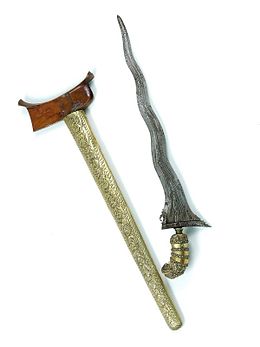Kris knife
Javanese (mainly & originally)
The kris (Ngoko Javanese: ꦏꦼꦫꦶꦱ꧀ ; Krama Javanese: ꦮꦁꦏꦶꦔꦤ꧀; Ngoko Gêdrìk: kêrìs; Krama Gêdrìk: wangkingan, lit. "to slice"; Thai: กริช kris, Minangkabau: karih, Tagalog: kalis; Bugis and Makassarese: sele) is an asymmetrical dagger with distinctive blade-patterning achieved through alternating laminations of iron and nickelous iron (pamor). While most strongly associated with the culture of Indonesia the kris is also indigenous to Malaysia, Thailand, Brunei, Singapore and the Philippines where it is known as kalis with variants existing as a sword rather than a dagger. The kris is famous for its distinctive wavy blade, although many have straight blades as well.
Kris have been produced in many regions of Indonesia for centuries, but nowhere—although the island of Bali comes close—is the kris so embedded in a mutually-connected whole of ritual prescriptions and acts, ceremonies, mythical backgrounds and epic poetry as in Central Java. As a result, in Indonesia the kris is commonly associated with Javanese culture, although other ethnicities are familiar with the weapon as part of their culture, such as the Balinese, Malays, Sundanese, Madurese, Banjar, Thais, Bugis, Makassar, and Filipinos.
...
Wikipedia

